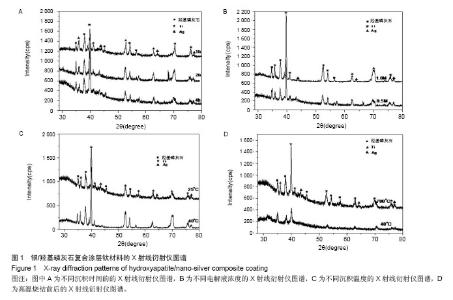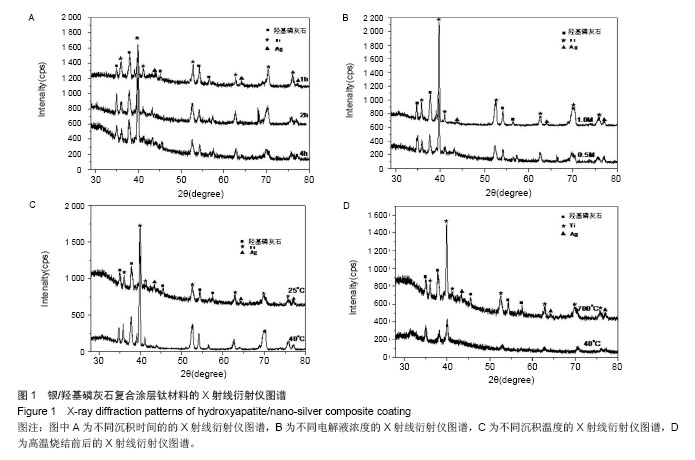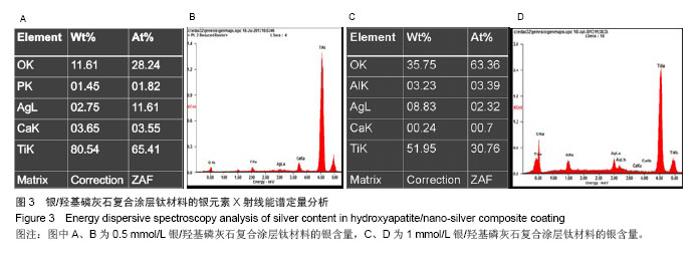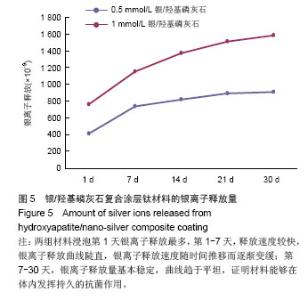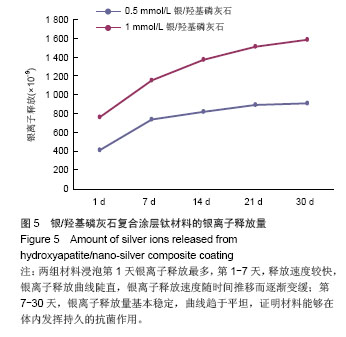Chinese Journal of Tissue Engineering Research ›› 2014, Vol. 18 ›› Issue (39): 6335-6341.doi: 10.3969/j.issn.2095-4344.2014.39.018
Previous Articles Next Articles
Release properties of titanium-based nano-silver coating
Xian Ai-ming, Zhang Xiao-gang, Cao Li, Wang Jia-ming, Peng Li-bin, Hu Yang
- Department of Orthopaedic Surgery, First Affiliated Hospital of Xinjiang Medical University, Urumqi 830054, Xinjiang Uygur Autonomous Region, China
-
Online:2014-09-17Published:2014-09-17 -
Contact:Cao Li, Professor, Chief physician, Doctoral supervisor, Department of Orthopaedic Surgery, First Affiliated Hospital of Xinjiang Medical University, Urumqi 830054, Xinjiang Uygur Autonomous Region, China -
About author:Xian Ai-ming, Studying for master’s degree, Attending physician, Department of Orthopaedic Surgery, First Affiliated Hospital of Xinjiang Medical University, Urumqi 830054, Xinjiang Uygur Autonomous Region, China -
Supported by:the Natural Science Foundation of Xinjiang Uygur Autonomous Region, No. 2013211A075
CLC Number:
Cite this article
Xian Ai-ming, Zhang Xiao-gang, Cao Li, Wang Jia-ming, Peng Li-bin, Hu Yang. Release properties of titanium-based nano-silver coating[J]. Chinese Journal of Tissue Engineering Research, 2014, 18(39): 6335-6341.
share this article
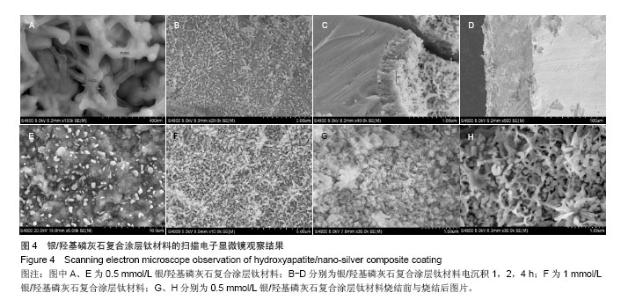
扫描电子显微镜观察结果,见图4。 扫描电镜可见,基本条件下制备的材料,复合涂层是由纳米针状羟基磷灰石和点状的银颗粒相互堆积而成的网状结构,银颗粒较均匀的分布于银/羟基磷灰石复合涂层中,羟基磷灰石晶体小于100 nm(图4A);沉积时间缩短至1 h,图像中可见涂层表面凹凸不平(图4B);延长沉积时间至4 h,涂层厚度明显增加(图4C,D);增加电解液中银离子浓度,涂层表面沉积的银颗粒增加(图4E,F);材料经过高温处理后,银颗粒分布均匀,无明显的团聚现象,羟基磷灰石的晶化度明显提高(图4H),与X射线衍射检测结果一致。 在材料的制备过程中,可以通过控制电流强度、电压大小、沉积温度以及溶液pH值等实验参数,来控制涂层的厚度、表面结构和孔隙率等来获取理想的材料。电解液中nCa/nP=1.67,等同于人体骨组织中的钙磷比,更加符合人体生理状况。 随着电解液温度的增加,银的特征峰相对增强,可能是温度增加改变了离子的热运动,更有利于银/羟基磷灰石的沉积,所以选择沉积温度为40 ℃。在材料的表征时发现,从1 h的扫描电镜图像中发现涂层凹凸不平,是钛片经过酸处理后表面不平,1 h沉积时间较短,涂层较薄,随着时间的增加,涂层的厚度增加,表面变得平坦;从4 h的扫描电镜图像中看到涂层表面有有絮状物覆盖,可能是由于沉积的时间增加,涂层的厚度增加,电阻逐渐增大而电流逐渐变小,影响了涂层表面的晶粒生长,故选择最佳沉积时间为2 h。"
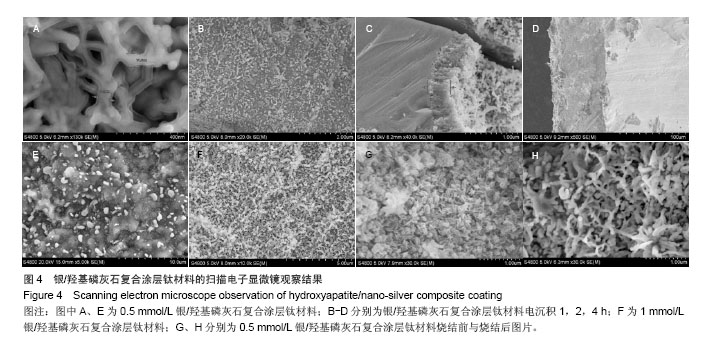

2.2 银/羟基磷灰石涂层材料在模拟体液中的银离子缓释结果 材料银离子释放具有一定规律性,两组材料浸泡第1天银离子释放最多,分别占30 d总量的45.55%和48.10%,均能够达到杀菌浓度;第1-7天,释放速度较快,银离子释放趋势图可见曲线陡直,维持有效杀菌浓度,银离子释放速度随时间推移而逐渐变缓;第7-30天,银离子释放量基本稳定,曲线趋于平坦,证明材料能够在体内发挥持久的抗菌作用(表1,图5);0.5 mmol/L银/羟基磷灰石组材料在第30天时释放总量低于细胞毒性浓度,1 mmol/L银/羟基磷灰石组材料第30天时释放总量接近细胞毒性浓度的临界值,前者用于临床更安全可靠。考虑到银离子释放量极少,远低于银离子的溶解饱和度[7],所以实验过程中没有更换浸提液。"

| [1]Laure B,Besnier JM,Bergemer-Fouquet AM,et al.Effect of hydroxyapatite coating and polymethylmethacrylate on stainless steel implant-site infection with Staphylococcus epidermidis in a sheep model.J Biomed Mater Res A. 2008; 84(1):92-98. [2]Trampuz A,Widmer AF.Infections associated with orthopedic implants. Curr Opin Infect Dis.2006;19(4):349-356. [3]Harris LG,Richards RG.Staphylococci and implant surfaces: a review. Injury.2006;37 Suppl 2:S3-S14. [4]Gristina AG,Naylor PT,Myrvik QN. Mechanisms of musculoskeletal sepsis. Orthop Clin North Am. 1991;22(3): 363-371. [5]王晓静,王国伟,赵铱民.金黄色葡萄球菌在不同种植体表面涂层粘附情况的体外实验研究[J].中国口腔种植学杂志, 2009,14(2):16. [6]朱梓园,张富强,郑学斌.含银抗菌羟基磷灰石涂层银离子的缓释性能[J].上海口腔医学, 2009,18(1):66-68. [7]佘文珺,张富强,胡滨,等.载银抗菌基托树脂银离子的缓释性研究[J].口腔医学, 2007,27(7):340-342. [8]Shirkhanzadeh M.Bioactive calcium phosphate coatings prepared by electrodeposition. Journal of materials science letters,1991;10(23):1415-1417. [9]Zhang J,Lin C,Feng Z,et al.Electrochemical preparation for bioactive ceramics coating on Ti-6Al-4V substrate.Chem J Chinese U.1997;18:961-962. [10]张建民,林昌健.电沉积磷酸钙生物活性陶瓷[J].物理化学学报, 1998,14(8):698-703. [11]张建民,石秋芝,杨长春,等.电流密度对钙磷沉积层组成和结构的影响[J].化学研究,2002,13(2):5-7. [12]赵中伟,陈爱良,陈星宇,等.脉冲阴极电沉积羟基磷灰石涂层[J].中国有色金属学报,2005,15(12):2023-2027. [13]王英波,鲁雄,赵婧,等. 脉冲电化学沉积制备 n-HA/ZrO2 复合涂层[J].稀有金属材料与工程,2009,38(6):1071-1075. [14]张柏林.电化学方法制备钛基纳米银/羟基磷灰石复合涂层及其相关性质研究[D].西南交通大学,2010. [15]Kim H,Kokubo T,Fujibayashi S,et al.Bioactive macroporous titanium surface layer on titanium substrate.J Biomed Mater Res.2000;52(3):553-557. [16]Lu X,Wang Y,Yang X,et al. Spectroscopic analysis of titanium surface functional groups under various surface modification and their behaviors in vitro and in vivo. J Biomed Mater Res A.2008;84(2):523-534. [17]Legeros RZ,Legeros JP.Calcium phosphate bioceramics: past, present and future. Key Eng Mater.2002;240:3-10. [18]卢旻鹏,蒋电明,权正学,等.载银纳米抗菌复合骨填充材料体外抗菌及缓释性能研究[J]. 中国修复重建外科杂志,2010,24(6): 691-695. [19]Casemiro LA,Martins CHG,Pires-de-Souza FDC,et al.Antimicrobial and mechanical properties of acrylic resins with incorporated silver--zinc zeolite--part I. Gerodontology. 2008;25(3):187-194. [20]Lee BU,Yun SH,Ji JH,et al.Inactivation of S.epidermidis,B.subtilis,and E.coli bacteria bioaerosols deposited on a filter utilizing airborne silver nanoparticles.J Microbiol Biotechnol.2008;18(1):176-182. [21]Panácek A,Kolár M,Vecerová R,et al.Antifungal activity of silver nanoparticles against Candida spp.Biomaterials. 2009;30(31):6333-6340. [22]Matsui Y,Otomo K,Ishida S,et al.Effect of silver-carrying photocatalyst “Hikari-Gintech”on mycobacterial growth in vitro. Microbiol Immunol.2004;48(7): 489-495. [23]Cardoso RF,Cooksey RC,Morlock GP,et al.Screening and characterization of mutations in isoniazid-resistant Mycobacterium tuberculosis isolates obtained in Brazil. Antimicrob Agents Chemother.2004;48(9):3373-3381. [24]Sun RW,Chen R,Chung NP,et al.Silver nanoparticles fabricated in hepes buffer exhibit, cytoprotective activities toward HIV-1 infected cells.Chem Commun.2005;(40): 5059-5061. [25]Lu L,Sun RW,Chen R,et al.Silver nanoparticles inhibit hepatitis B virus replication.Antivir Ther.2008;13(2): 253-262. [26]张若愚,夏雪山,胡亮,等.Ag/Diatomite复合材料及其对禽流感病毒的杀灭研究[J].贵金属,2004,25(2):28-32. [27]Lok CN,Ho CM,Chen R,et al.Proteomic analysis of the mode of antibacterial action of silver nanoparticles.J Proteome Res. 2006;5(4):916-924. [28]Welz B.原子吸收光谱法:第二次全修订版[M].李家熙等译.北京:地质出版社,1989. [29]马怡载.石墨炉原子吸收分光光度法[M].北京市:原子能出版社, 1989. [30]Liau SY,Read DC,Pugh WJ,et al.Interaction of silver nitrate with readily identifiable groups: relationship to the antibacterial action of silver ions. Lett Appl Microbiol. 1997; 25(4):279-283. [31]Kawahara K,Tsuruda K,Morishita M,et al.Antibacterial effect of silver-zeolite on oral bacteria under anaerobic conditions. Dent Mater.2000;16(6):452-455. [32]常涛.银离子消毒剂研究概述[J].解放军预防医学杂志, 2005, 23(1):75-77. [33]Qu F,Xu H,Wei H,et al.Effects of pH and Temperature on Antibacterial Activity of Silver Nanoparticles[R]. Yantai: Computer Science of Yantai University, 2010:2033-2037. [34]Dong Y,Li X,Tian L,et al.Towards long-lasting antibacterial stainless steel surfaces by combining double glow plasma silvering with active screen plasma nitriding.Acta Biomaterialia. 2011;7(1):447-457. [35]Matsumura Y,Yoshikata K,Kunisaki S,et al.Mode of bactericidal action of silver zeolite and its comparison with that of silver nitrate. Appl Environ Microbiol. 2003;69: 4278-4281. [36]阮洪江,范存义,郑学斌,等.载银羟基磷灰石抗菌涂层抗菌性能及对成骨细胞影响的体外实验[J].科学通报,2009,54(1):60-66. |
| [1] | Li Xingping, Xiao Dongqin, Zhao Qiao, Chen Shuo, Bai Yiguang, Liu Kang, Feng Gang, Duan Ke. Preparation and properties of copper-loaded antibacterial functional film on titanium surface [J]. Chinese Journal of Tissue Engineering Research, 2021, 25(4): 553-557. |
| [2] | Shi Xiaoxiu, Mao Shilong, Liu Yang, Ma Xingshuang, Luo Yanfeng. Comparison of tantalum and titanium (alloy) as orthopedic materials: physical and chemical indexes, antibacterial and osteogenic ability [J]. Chinese Journal of Tissue Engineering Research, 2021, 25(4): 593-599. |
| [3] | Zhang Xianjun, Zhao Xijiang. In vivo osteogenic properties of silicon-incorporated titanium dioxide nanotubes on titanium screw surface [J]. Chinese Journal of Tissue Engineering Research, 2021, 25(16): 2461-2465. |
| [4] | Liu Zige, Liu Xinrui, Li Yan, Song Guorui, Zhang Chen, Chen Desheng. In vitro experiment of tetrandrine on the model of osteolysis induced by wear particles around the prosthesis [J]. Chinese Journal of Tissue Engineering Research, 2021, 25(15): 2358-2363. |
| [5] | Wu Shengxiang, Liu Yuan, Lu Shuai. Mini-locking titanium plate system fixation in the treatment of carpal scaphoid fracture [J]. Chinese Journal of Tissue Engineering Research, 2021, 25(12): 1874-1878. |
| [6] | Zhang Lixing, Tian Ang, Li Xi, Bai Xizhuang. Drug-release characteristic and biological toxicity of TiO2 nanotube/hydroxyapatite loaded vancomycin coating [J]. Chinese Journal of Tissue Engineering Research, 2021, 25(10): 1500-1506. |
| [7] | Gu Yuanping, Lu Chenghui . Cleaning efficacy of two kinds of mechanical nickel-titanium instruments in preparation of severely curved root canals: a scanning electron microscopic study [J]. Chinese Journal of Tissue Engineering Research, 2021, 25(10): 1566-1570. |
| [8] | Liu Chundong, Shen Xiaoqing, Zhang Yanli, Zhang Xiaogen, Wu Buling. Effects of strontium-modified titanium surfaces on adhesion, migration and proliferation of bone marrow mesenchymal stem cells and expression of bone formation-related genes [J]. Chinese Journal of Tissue Engineering Research, 2020, 24(7): 1009-1015. |
| [9] | Yang Xu, Zhao Xiaofeng, Qi Detai, Wang Xiaonan, Jin Yuanzhang, Zhou Runtian, Zhao Bin. Changes in cervical sagittal balance after three-dimensional printing ACT titanium cage in anterior cervical discectomy with fusion [J]. Chinese Journal of Tissue Engineering Research, 2020, 24(36): 5741-5748. |
| [10] | Zhang Hui, Xu Nanwei, Nong Luming, Tang Xueming, Zhou Xindie, Jiang Wei. Factors influencing the prognosis of central cord syndrome treated with drug therapy and titanium plate fixation [J]. Chinese Journal of Tissue Engineering Research, 2020, 24(3): 348-353. |
| [11] | Yang Xiao, Mei Wei, Zhang Wei. Absorbable rod or titanium alloy screws for Mason type II radial head fractures [J]. Chinese Journal of Tissue Engineering Research, 2020, 24(27): 4328-4332. |
| [12] |
Zhang Xuan, Li Yunpeng, Zhang Xuejian, Yin Chuanrong, Deng Yue.
Guided bone regeneration using preformed titanium mesh combined with bioabsorbable membranes in aesthetic area [J]. Chinese Journal of Tissue Engineering Research, 2020, 24(26): 4112-4117. |
| [13] | Zhang Lan, Wang Xiang, Liu Jun, Zhang Chunqiu, Ye Jinduo, Liu Lu. Tensile properties of three-dimensional printed porous titanium alloy trabecular bone [J]. Chinese Journal of Tissue Engineering Research, 2020, 24(22): 3498-3503. |
| [14] | Wang Yanling, Shao Zhe, He Wei. Micro-arc oxidation and osteoblast proliferation and osteogenic differentiation ability on titanium surface [J]. Chinese Journal of Tissue Engineering Research, 2020, 24(22): 3486-3490. |
| [15] | Sun Xirao, Wang Chengyue, Zhao Yuan, Zhang Zhenbao. In vitro corrosion and in vivo biosafety of pure magnesium film [J]. Chinese Journal of Tissue Engineering Research, 2020, 24(16): 2578-2584. |
| Viewed | ||||||
|
Full text |
|
|||||
|
Abstract |
|
|||||
